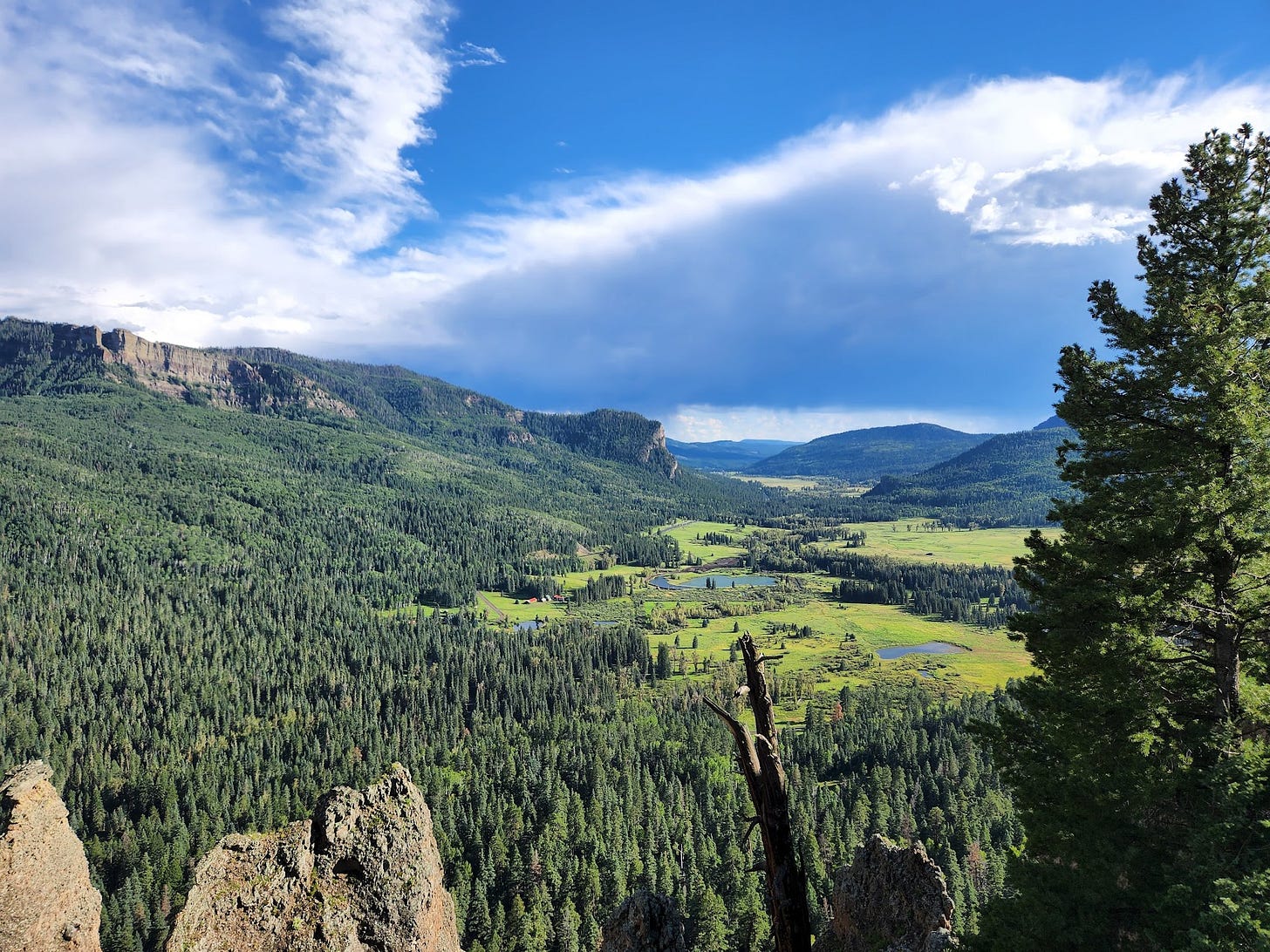Going elsewhere.
A girls trip to see the world, free from screens.
My sister needed to pick up some sheep she’d purchased, and so the three sisters headed to New Mexico in a pickup truck with a portable trailer in the back. It was going to be a hard drive there and back again.
It wasn’t until a Coffee Cup truck stop in South Dakota that I could relax, for despite multiple stops in Pierre, that was the only place I was able to find a road atlas.
“I don’t trust Google,” I said repeatedly. “We need a road atlas just in case.”
One sister is all about geocaching, so we put her in charge of calling out upcoming caches on our route. My other sister is all about herbalism and taking photos of medicinal “weeds.” I like a good joke so at one point I crouched down behind rocks and had a photo taken that looked like I was falling off of a cliff, sending it to the family Telegram group and promptly getting my mom to wonder if I was alright.
I could regale you with tales of geocaching and bawdy jokes and listening to 80s tunes and jammin’ to Jon Bon Jovi and the peculiarities of dually pickups in narrow constructions zones, but mostly I’d like to tell you about elsewhere.
Do you remember the TV show St. Elsewhere?
I don’t; we didn’t have a TV and my parents would never have let me watch that show even if we did. But I do remember the theme song and I do remember reading about the pilot episode in which they briefly explain the name. The premise was that you could go to the better, bigger hospital, or you could go to St. Eligius with its quirky staff and less than elegant surroundings. The latter was lesser, and jokingly referenced as “St. Elsewhere.”
I don’t know about the sainthood of where we traveled, but it was elsewhere.
Western Nebraska and Kansas are rough. For all the jokes about North Dakota, at least we weren’t in a drought. I’ve never felt so heartsick looking out across the driest, bleakest landscape wondering what the ranchers and farmers could possibly do.
Colorado, much like Wyoming, has fooled people who have never been there. Outsiders imagine the whole state to be breathtaking mountains, as if the Fourteeners make up Colorado in its entirety and Wyoming is all Grand Tetons. They don’t seem to realize the very flat and arid eastern plains that push up against those mountains.
In a few places, it appeared as if some rancher had sold his vast pastures to a developer who had plotted them out. People must have spent all of their money to get their little plot of land, leaving them with very little to homestead with. RVs and garden sheds and shacks nearly as ramshackle as I saw in Nicaragua seemed tossed out on the landscape without rhyme or reason. But if you looked, you could make out a grid, a plot system.
I’d seen a documentary several years ago about a similar situation elsewhere in the American southwest. Some people were squatters, living on an arid plateau without electricity and running water, cobbling together an odd community with tight connections and some serious problems. I wondered if this were similar.
“I guess we’re looking at someone’s dream,” I said as we drove along the plateau in Colorado. We were all a little taken aback. I pointed out the lack of significant power lines.
“I’ll never make jokes about my farm again,” my sister said. Maybe she was thinking about the little shelters she made for her pigs, the ones made out of pickup toppers. Those pigs were living close to the same standard as some of those homes. The Dakotas were looking like a lush paradise.
I wondered how many people had moved to some of those plains for their dream of living in or near the mountains of Colorado, free from urban society, only to find themselves in a Twilight Zone kind of suburbs. Maybe that’s exactly the kind of suburbs they wanted. Maybe they wanted a simpler life, a little acreage, a place to grow some food and raise a few animals. Now and then you’d see a plot where the owner had the money to actually build a house and garage.
I’m guessing some loved it; more power to them. It was very dry and a hard-scratch living and they must be tough.
When I checked into our hotel in Colorado Springs—a very nice hotel that probably wasn’t used to a bunch of farm hicks parking a truck full of sheep in their parking lot—the fellow at the counter was very pleasant.
Suddenly, in the midst of the usual check-in spiel, he dropped his voice. “I like your shirt,” he said quietly.
I was wearing a black T-shirt that said Control Group on it.
I was a bit surprised. Colorado is left-leaning. “Thanks,” I said. “Not everyone appreciates it. Glad to see the rebellion is widespread.”
He chuckled, and then got on with the check-in process.
I’m always amazed when I travel—particularly on road trips—at the variety of life in the United States. The geography, the culture, the different way of being despite most people being the same. For the most part, we can still find a connection despite being so digitally connected to have nearly destroyed that ability. It is something we all ought to do, hit that open American road and mix with the rest of our fellow citizens so we could stop seeing them as an other, from St. Elsewhere.
Of course, one of the best things about visiting St. Elsewhere is realizing you live in St. Home.
The Rockies are pretty and the Nebraska sandhills have their own peculiar charm, but it was a lot of driving and diesel vehicles are a hassle and I was glad to get back to the Dakotas.





